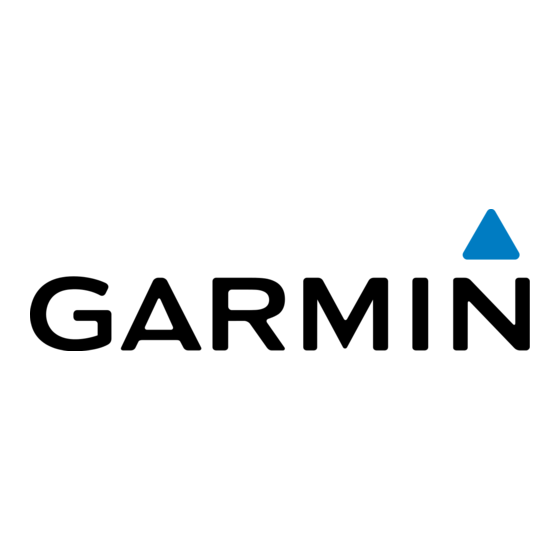- ページ 43
船舶用GPSシステム Garmin nuvi 500-SeriesのPDF オーナーズマニュアルをオンラインで閲覧またはダウンロードできます。Garmin nuvi 500-Series 50 ページ。 Flush mount template
Garmin nuvi 500-Series にも: クイック・リファレンス・マニュアル (2 ページ), ユーザーマニュアル (28 ページ), オーナーズマニュアル (38 ページ), 重要なお知らせ (1 ページ), オーナーズマニュアル (44 ページ), 取付説明書 (6 ページ)

You can set the parameters the chartplotter uses when
calculating an Auto Guidance path.
Preferred Depth: Sets the minimum water depth, based on
chart depth data, that your boat can safely travel over.
NOTE: The minimum water depth for the premium charts
(made before 2016) is 3 feet. If you enter a value of less than
3 feet, the charts only use depths of 3 feet for Auto Guidance
path calculations.
Vertical Clearance: Sets the minimum height of a bridge or
obstacle, based on chart data, that your boat can safely
travel under.
Shoreline Distance: Sets how close to the shore you want the
Auto Guidance path to be placed. The Auto Guidance path
may move if you change this setting while navigating. The
available values for this setting are relative, not absolute. To
ensure that the Auto Guidance line is placed the appropriate
distance from shore, you can assess the placement of the
Auto Guidance path using one or more familiar destinations
that require navigation through a narrow waterway
the Distance from Shore, page
Adjusting the Distance from Shore
The Shoreline Distance setting indicates how close to the shore
you want the Auto Guidance line to be placed. The Auto
Guidance line may move if you change this setting while
navigating. The available values for the Shoreline Distance
setting are relative, not absolute. To ensure the Auto Guidance
line is placed the appropriate distance from shore, you can
assess the placement of the Auto Guidance line using one or
more familiar destinations that require navigation through a
narrow waterway.
1
Dock your vessel or drop the anchor.
2
Select Settings > Navigation > Auto Guidance > Shoreline
Distance > Normal.
3
Select a destination that you have navigated to previously.
4
Select Navigate To > Auto Guidance.
5
Review the placement of the Auto Guidance line, and
determine whether the line safely avoids known obstacles
and the turns enable efficient travel.
6
Select an option:
• If the placement of the Auto Guidance line is satisfactory,
select Menu > Stop Navigation, and proceed to step 10.
• If the Auto Guidance line is too close to known obstacles,
select Settings > Navigation > Auto Guidance >
Shoreline Distance > Far.
• If the turns in the Auto Guidance line are too wide, select
Settings > Navigation > Auto Guidance > Shoreline
Distance > Near.
7
If you selected Near or Far in step 6, review the placement of
the Auto Guidance line, and determine whether the line
safely avoids known obstacles and the turns enable efficient
travel.
Auto Guidance maintains a wide clearance from obstacles in
open water, even if you set the Shoreline Distance setting to
Near or Nearest. As a result, the chartplotter may not
reposition the Auto Guidance line, unless the destination
selected requires navigation through a narrow waterway.
8
Select an option:
• If the placement of the Auto Guidance line is satisfactory,
select Menu > Stop Navigation, and proceed to step 10.
• If the Auto Guidance line is too close to known obstacles,
select Settings > Navigation > Auto Guidance >
Shoreline Distance > Farthest.
• If the turns in the Auto Guidance line are too wide, select
Settings > Navigation > Auto Guidance > Shoreline
Distance > Nearest.
Chartplotter Data Management
(Adjusting
13).
9
If you selected Nearest or Farthest in step 8, review the
placement of the Auto Guidance line, and determine
whether the line safely avoids known obstacles and the turns
enable efficient travel.
Auto Guidance maintains a wide clearance from obstacles in
open water, even if you set the Shoreline Distance setting to
Near or Nearest. As a result, the chartplotter may not
reposition the Auto Guidance line, unless the destination
selected requires navigation through a narrow waterway.
10
Repeat steps 3 through 9 at least once more, using a
different destination each time, until you are familiar with the
functionality of the Shoreline Distance setting.
Other Vessel Settings
When your compatible chartplotter is connected to an AIS
device or VHF radio, you can set up how other vessels are
displayed on the chartplotter.
Select Settings > Other Vessels.
AIS: Enables and disables AIS signal reception.
DSC: Enables and disables digital selective calling (DSC).
AIS Alarm: Sets the collision alarm
Collision Alarm, page 7
Alerts, page
7).
Restoring the Original Chartplotter Factory
Settings
NOTE: This procedure deletes all settings information you have
entered.
Select Settings > System > System Information > Factory
Settings.
Chartplotter Data Management
Copying Waypoints, Routes, and Tracks
from HomePort to a Chartplotter
Before you can copy data to the chartplotter, you must have the
latest version of the HomePort software program loaded on your
computer and a memory card installed in the chartplotter.
Copy the data from HomePort to the prepared memory card.
For more information, see the HomePort help file.
Selecting a File Type for Third-Party
Waypoints and Routes
You can import and export waypoints and routes from third-party
devices.
1
Select Nav Info > Nav Info > Data Transfer > File Type.
2
Select GPX.
To transfer data with Garmin devices again, select the ADM file
type.
Copying Data from a Memory Card
1
Insert a memory card into a card slot.
2
Select Nav Info > Manage Data > Data Transfer.
3
If necessary, select the memory card to copy data to.
4
Select an option:
• To transfer data from the memory card to the chartplotter
and combine it with existing user data, select Merge from
Card.
• To transfer data from the memory card to the chartplotter
and overwrite existing user data, select Replace from
Card.
5
Select the file name.
(Setting the Safe-Zone
and
Enabling AIS Transmission Test
37
